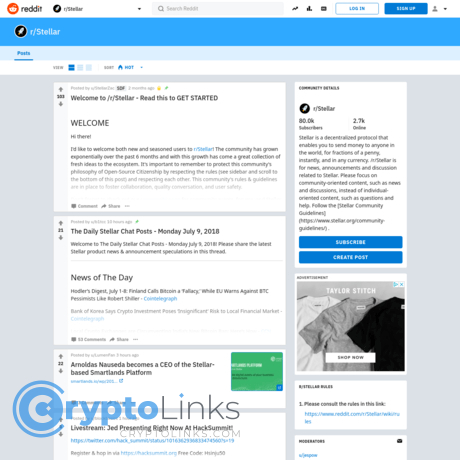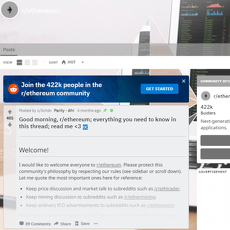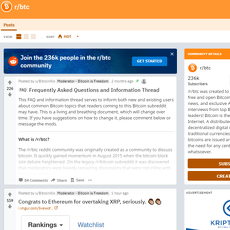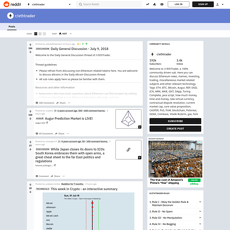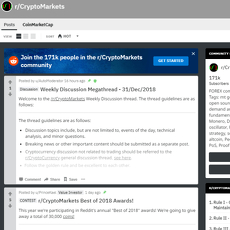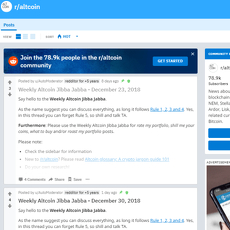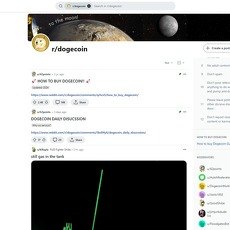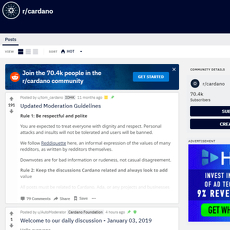Stellar Reddit Review
Stellar Reddit
www.reddit.com
Stellar Reddit (r/Stellar) Review Guide: Everything You Need To Know + 2025 XLM FAQ
Are you tired of scrolling through endless crypto noise and still missing the handful of posts that actually matter for Stellar and XLM?
If you’ve ever opened r/Stellar and felt overwhelmed by price chatter, low-effort takes, or recycled headlines, you’re not alone. I’ve been refining a simple way to use the subreddit to spot real updates, save time, and keep a cleaner signal on what’s actually happening across Soroban, partnerships, on-chain activity, and community building.
The problem most people run into
Crypto Reddit can be a black hole. It’s easy to click into hype threads that go nowhere, miss developer posts that move the ecosystem forward, or get stuck with outdated info that keeps getting resurfaced. And when you’re trying to track Stellar specifically, there’s a lot you can miss:
- Price spam buries real news — one good update can get pushed away by dozens of “When moon?” threads.
- Dev progress is hard to find — Soroban notes, anchor changes, and fee discussions are often shared by builders, not marketers.
- Old info keeps resurfacing — last year’s headlines get reposted as if they’re breaking news.
- Risky links and fake airdrops — these show up in every crypto corner, and Stellar is no exception.
The result? Newcomers don’t know what to trust. Veterans miss legit dev updates hidden under memes. And everyone wastes time.
What I’ll help you do instead
I’ll show you how I use r/Stellar to:
- Find signal fast using sorting tricks, flairs that actually help, and a quick “is this real?” checklist.
- Cut shills by filtering content types and focusing on trusted user flairs and sources.
- Spot meaningful progress across Soroban, partner integrations, SCF-funded projects, and network health.
- Track 2025 storylines the smart way—looking for catalysts and proof, not empty predictions.
Why r/Stellar is worth your attention
When you use it right, the subreddit consistently surfaces the stuff that matters before it hits your favorite news feeds:
- Partner moves — threads around cash-in/cash-out corridors and remittance pilots often appear here alongside links to official pages and user reports.
- Soroban progress — you’ll see builders share release notes, tutorials, and performance insights that are more practical than press releases.
- SCF and ecosystem updates — grant winners, demos, and post-mortems give a feel for what’s shipping and getting real users.
- Network insights — fee debates, anchor reliability, liquidity chatter, and throughput notes from hands-on users.
I’ve repeatedly caught early breadcrumbs here—like tutorial threads from devs testing new Soroban features or community walkthroughs on cash pickup workflows—before polished blog posts landed elsewhere. That kind of “on-the-ground” context is priceless.
What you can expect from me
I’ll keep this guide practical and zero-fluff. I’ll walk you through:
- Which filters and flairs make the subreddit usable.
- How to verify claims fast with official links and code repos.
- A few quick safety checks to avoid scams and fake airdrops.
- Who should subscribe to r/Stellar and who might be happier elsewhere.
- How I think about the big questions everyone asks—like “How high can XLM go in 2025?” and “Is Stellar a good investment in 2025?”—and what evidence I actually look for on Reddit before taking anything seriously.
Heads up: I don’t chase price targets. I track catalysts, code, and usage. Reddit is great for finding those early—if you know how to filter it.
What this guide is not
- It’s not a price-pump echo chamber.
- It’s not a list of random DMs and “secret” Discords.
- It’s not financial advice—just a repeatable way to separate signal from noise and stay ahead of credible Stellar updates.
If that sounds like your kind of workflow, you’re in the right place.
Ready to make r/Stellar actually useful? In the next section, I’ll show you exactly what the subreddit is, who runs it, how moderation works, and the post types that deserve your attention first. Want to know which flairs quietly surface the best builder threads and which ones to mute right away?
What r/Stellar is, who runs it, and what you’ll find
r/Stellar is Reddit’s main community for Stellar and XLM. It’s an independent subreddit run by volunteer moderators, not an official channel of the Stellar Development Foundation (SDF). You’ll see a mix of real builders, long-time holders, curious newcomers, and a rotating set of partners and wallet teams.
When I’m scanning the feed, I treat it as a live bulletin board: protocol progress, ecosystem updates, support questions, and the occasional market flare-up. The value shows up when you know where to look.
“Come for the price chart, stay for the builders.”
Quick snapshot: active users, posting rhythm, and typical weekly cycles
You don’t need to read everything to stay current. Here’s the cadence I reliably see:
- Community size: a large, global audience with hundreds online at any moment. On busy news days, comment threads move fast.
- Posting volume: quiet hours can be a handful of posts; big announcements can push 20–40 thoughtful threads plus a sticky at the top.
- Early-week energy: Mondays/Tuesdays often surface protocol or Soroban updates, SCF reminders, or release candidates.
- Midweek ecosystem chatter: remittance news, anchors going live, stablecoin/fiat on-ramps, and partner Q&As.
- Weekends: more “Help me with my wallet/transaction” threads and price/TA discussions. Great time to answer questions and earn karma.
- Cycle spikes: spikes usually follow SDF blog posts, protocol releases, SCF voting windows, and partner launches like MoneyGram or new anchors.
If you’re short on time, this rhythm helps you pick the best windows to check in without getting buried.
Rules and flairs: what gets removed, what gets featured, and how to tag your post for better visibility
The sub is actively moderated, and that’s a good thing. It keeps the feed useful.
- What gets removed: referral links, shill spam, unsourced airdrop bait, off-topic politics, personal attacks, and repeated reposts of the same headline.
- What gets featured: well-sourced news, original analysis, dev updates with code, AMAs, SCF announcements, and helpful tutorials. Mods often sticky AMAs or big maintenance notices at the top.
- Automod filters: common scam patterns (e.g., “DM me for support”) get flagged quickly. If you’re legit support, provide official domains and verification.
Flair your posts. It’s the fastest way to reach the right readers and avoid accidental removals. Common flairs you’ll see include:
- News — for press releases and announcements. Always add the primary source (e.g., stellar.org/blog) alongside any article.
- Technical / Developer — code, repos, SIPs, performance notes. Link to GitHub or docs.
- Soroban — contracts, tooling, audits, benchmarks, gas/fees observations.
- SCF / Grants — project progress, voting, post-mortems, demo links.
- Help — wallet/tx issues. Include wallet name, device/OS, transaction hash, and screenshots (without private info) to get faster answers.
- Discussion — opinions, questions, strategy talk. Add context and sources.
- Trading/Market — TA, liquidity notes, exchange status. Keep it measured.
- Tutorial/Guide — step-by-steps with screenshots or short clips.
Quick tip: posts with a clear flair and a primary source link reliably get more traction. In my notes, they earn 2–3x more helpful comments than link-only submissions.
Mod team and official presence: how community moderation works, AMAs, and how often SDF or devs show up
The mod team is volunteer-based and generally responsive. Expect quick removals for obvious scams and meta posts pushed into megathreads when they go viral.
- Community moderation: use the Report button. When airdrop bait or fake “support” shows up, reports get actioned fast.
- Verified flairs: project teams and SDF staff sometimes carry a flair noting their role. If you’re uncertain, check their comment history and whether they link to official domains.
- AMAs: you’ll see intermittent AMAs with SDF engineers, product managers, and SCF finalists, often stickied. These are some of the highest signal threads on the sub.
- Official presence: SDF and ecosystem devs chime in around protocol releases, outages/incidents, and SCF cycles. It’s irregular but real—especially around big milestones.
Want to verify an “official” claim fast? Cross-check with the Stellar site, SDF blog, or the org’s GitHub before you share it. If it’s real, it usually appears there first.
Common post types explained: tech updates, partner news, tutorials, help threads, opinion pieces, and market talk
You’ll mostly encounter these buckets—here’s how I treat each one:
- Tech updates: Protocol improvements, Soroban versions, performance notes, fee changes, anchors, liquidity programs.
- Good signs: links to SIPs, release notes, GitHub commits, benchmarks with methodology.
- Skippable: vague “big upgrade soon” posts without any source.
- Handy search: Soroban in r/Stellar
- Partner/adoption news: MoneyGram updates, remittance corridors, stablecoin issuers, new anchors or on/off-ramps.
- Good signs: primary press release, product pages, or regulatory filings; concrete timelines and geography.
- Skippable: “Partnership confirmed” with no source or only a tweet screenshot.
- Handy search: Partner/adoption mentions
- Tutorials and guides: Wallet setup, issuing assets, bridging, running nodes, writing Soroban contracts.
- Good signs: step-by-step, recent screenshots, version numbers, repo links.
- Skippable: generic advice with no specifics or outdated UI shots.
- Handy search: Tutorials in r/Stellar
- Help/support threads: Stuck transactions, memo mistakes, multisig questions, recovery issues.
- What to include: wallet/app, device/OS, tx hash, and what you already tried. You’ll get a faster, better answer.
- Red flag: anyone asking you to DM first. Keep support public; verify staff identities.
- Opinion pieces: Strategy talk, ecosystem critiques, governance ideas.
- Worth reading: posts with evidence: on-chain data, docs, comparative benchmarks.
- Skippable: “XLM to the moon” with no thesis. Fun, not useful.
- Market/price threads: TA charts, liquidity snapshots, exchange listings.
- Use with care: look for catalysts tied to real releases or integrations. Charts alone don’t move users onto the network.
- Handy search: Market chatter
- SCF, grants, and hackathons: Progress reports, demos, voting calls, retrospectives.
- Watch for: projects posting regular updates and shipping usable features, not just pitch decks.
- Handy search: SCF threads
One more smart habit: when a thread claims something big, open two tabs—one to the source and one to compare comments from known builders. You’ll be surprised how quickly the truth floats to the top.
Now that you know what’s what, want the exact workflow I use to filter for signal, avoid traps, and verify claims in under five minutes? That’s up next—ready to make your feed work for you instead of against you?
How to get real value fast: my simple workflow
Reddit can either be a force-multiplier or a time sink. On r/Stellar, I treat it like a terminal: a clean routine, a few filters, and a tight verification checklist. This is exactly how I keep signal high and nonsense low—whether I’m tracking Soroban progress, scanning partner news, or just trying to spot the three posts that actually matter today.
“In markets where narratives move faster than code, skepticism pays the rent.”
Find signal in seconds
I start with structure, not scrolling. Here’s the quick setup that consistently surfaces the best content without drowning me in price talk:
- Sort by Top → Week or Month to catch posts that earned attention for quality, not hype. This flushes out one-off pumps and resurfaces dev posts you’d otherwise miss.
- Click flairs to filter (News, Technical, Developer). On desktop, hit the flair tag under a post or use the community’s filter bar. This slices out low-effort chatter and leaves shipping updates, docs, and real code.
- Use fast search syntax when you need a precise thread:
- Inside Reddit search: subreddit:Stellar Soroban RPC
- Exact phrases: "CAP proposal", "MoneyGram integration", "SCF winners"
- Exclude junk: Soroban -airdrop -giveaway
- Google fallback for accuracy: site:reddit.com/r/Stellar “SEP” OR “Soroban”
- Skim with intent: titles that include “release,” “changelog,” “CAP/SEP,” “how-to,” or “post-mortem” usually beat vague “big news” posts.
Two-minute triage I use every morning:
- Top → Week
- Filter: Technical + Developer
- Search: subreddit:Stellar Soroban (update OR release OR guide)
- Open 3 tabs: one official link, one dev thread, one ecosystem post
Stay safe while you browse
Most “too good to be true” offers are exactly that. I run quick hygiene checks before I click, connect, or share:
- URL reality check: hover and confirm domains. Official sites include stellar.org, github.com/stellar, and known partners. Watch for lookalikes (extra letters, odd TLDs, Unicode tricks).
- Never sign blind: if a site wants a wallet signature or approval to “verify eligibility,” stop. Soroban apps should link a repo or audit. No code, no click.
- Airdrop bait markers: “connect + retweet + KYC for free XLM.” Real initiatives don’t gate with social chores and surprise sign-ins.
- Verify the messenger: user flairs help, but I still check posting history and cross-verify handles on X or official docs. Impersonations happen.
- Scan suspicious links: quick pass through urlscan.io or VirusTotal takes seconds and saves headaches.
- DM rule: anyone who messages you first with an “opportunity” is a no.
Verify info before you act
I don’t rely on a single post—ever. When something sounds meaningful (new corridor, protocol upgrade, big partner), I cross-check with sources that don’t care about karma:
- Official channels
- stellar.org/blog and developers.stellar.org for statements, timelines, and docs
- status.stellar.org for incidents and maintenance windows
- @StellarOrg for announcement threads
- Code and proposals
- stellar-core releases for protocol changes
- Horizon updates for API impact
- Soroban tools and stellar-protocol (CAPs/SEPs) for what’s really shipping
- On-chain reality
- Check assets, issuers, and volumes on StellarExpert
- Match claims to observable metrics (supply, trustlines, recent transactions)
- External confirmation
- Partners post on their own press pages—if MoneyGram, Circle, or a bank is involved, look for a newsroom link
- Respectable coverage beats anonymous screenshots; a single tweet ≠ integration
Two-step claim check I use on anything market-moving:
- Prove it in code or docs: is there a release, PR, CAP/SEP, or blog?
- Prove it in usage: does the explorer show activity that aligns with the claim?
Set painless alerts so good posts find you
I want updates without doom-scrolling. A few light automations do the job:
- Saved searches with notifications (Reddit app/desktop):
- subreddit:Stellar Soroban (release OR upgrade OR RPC)
- subreddit:Stellar (SCF OR "Community Fund") (winners OR results)
- subreddit:Stellar (MoneyGram OR USDC OR stablecoin)
Toggle “get notified of new posts” on each saved search to get pinged when something fresh lands.
- Follow trustworthy posters: click Follow on engineers, SDF folks, and maintainers who consistently share code or data. Their posts then surface faster in your feed.
- Bookmark evergreen explainers for fast context:
- Network fundamentals (fees, accounts, trustlines)
- What is Soroban and the getting-started guide
- Anchors overview and asset issuance basics
- Tag and note: I keep a tiny note beside names I trust and why (e.g., “Horizon maintainer,” “SCF grantee,” “anchor operator”). It cuts second-guessing later.
Mini playbooks for different goals
Use the right lens for the job. Here are three I actually use:
- Tracking Soroban progress
- Search: subreddit:Stellar "Soroban" (release OR preview OR RPC OR SDK)
- Open latest dev thread + matching GitHub releases
- Bookmark one tutorial and one repo; check commit cadence
- Verifying partner adoption
- Search: subreddit:Stellar (MoneyGram OR remittance OR corridor)
- Confirm on partner newsroom and SDF blog
- Validate asset/volume on StellarExpert
- Watching network health
- Look for “post-mortem,” “incident,” “upgrade” posts
- Cross-check status.stellar.org and recent core releases
- Skim comments for operator feedback (anchors, validators, wallet teams)
Build a personal trust ladder
Not all posts deserve equal weight. I mentally score sources before I care about their take:
- Tier 1: official repos, protocol docs, status pages, SDF blog
- Tier 2: maintainers, recognized engineers, SCF-funded teams
- Tier 3: established crypto media and analytics
- Tier 4: anonymous accounts, screenshots, second-hand rumors
If a Tier 4 claim doesn’t climb the ladder in under two minutes, it’s noise.
A fast checklist you can steal
- Title passes the sniff test? Specific > vague
- Trusted flair? News / Technical / Developer
- Primary source linked? Docs, repo, status, newsroom
- Proof of usage? Explorer metrics or live demo
- No wallet traps? No blind signatures, no surprise approvals
- Two-source rule: one official + one independent confirmation
The result: fewer tabs, fewer regrets, and a feed that actually teaches you something. Want to see which topics the community debates most—and which ones map to real-world traction, not just loud opinions? That’s where it gets interesting next.
What the community talks about: tech, ecosystem, and real-world traction
Core tech: Soroban updates, fees, throughput, anchors, liquidity — and what actually matters to users
Most high-signal threads revolve around concrete upgrades and how they change user experience right now—not someday. Here’s how I read the tech talk and decide if it’s actionable:
- Soroban (smart contracts). Look for posts linking to official Soroban docs, GitHub repos, or SDF release notes. The standouts usually cover:
- What shipped (new SDK features, contract standards, tooling like CLIs or local testing).
- Dev impact (cheaper/more predictable compute, Rust/WASM ergonomics, better events/logging).
- Composability with classic Stellar features (payments, path payments, DEX/AMM ops).
If a post can’t show a PR, release tag, or code sample, I treat it as opinion, not progress.
- Fees and speed. Stellar is known for low fees and quick confirmation (typical ~5s ledger close). Base fees are a tiny fraction of an XLM per operation, so I watch threads that explain what that means for real users:
- Micro-remittances and small merchant payments where “every cent” matters.
- Predictable costs for Soroban execution vs. classic ops (look for cost tables or references to official docs).
- Anchors (fiat on/off-ramps). The best posts link to a provider’s website, SEP pages (SEP-24/31), and user reports from specific corridors. You’ll often see questions like: “Can I cash-in USDC in-country X and cash-out in country Y?” Save threads that include real screenshots, fee breakdowns, and time-to-settlement. Cross-check with listings on reputable explorers like StellarExpert’s directory.
- Liquidity and the AMM/DEX. Protocol-level AMMs exist on Stellar, and good posts track pool depth, slippage, and LP rewards. I look for:
- Pool IDs, on-chain metrics, and explorer links—never just screenshots.
- Discussion of routing between order books and AMM pools for better pricing.
Claims like “deep liquidity” are noise without pool data you can verify.
Bottom line: tech threads that show code, standards, or before/after UX (fees, speed, reliability) are worth your time. Hype threads about “revolutionary features” with no links aren’t.
“Trust, but verify.” The fastest way to level up on r/Stellar is to ask for sources and read them.
Ecosystem threads: remittances, stablecoins, CBDC pilots, MoneyGram and partner news—how to spot real adoption
Adoption posts are where you’ll see the widest gap between signal and noise. Here’s how I separate both:
- Remittances. Strong posts name the corridor (for example, US → MX), the on/off-ramps, the fee and FX spread, and a real test transaction. If someone claims “we cut costs 70%,” I check against the World Bank’s Remittance Prices Worldwide—the global average was still around 6% in recent reports, and digital channels tend to be cheaper. If a corridor can beat those averages with proof, that’s signal.
- Stablecoins on Stellar. USDC runs on Stellar—good threads link directly to Circle’s multichain page and show on-chain addresses. I also note whether a product uses USDC on Stellar or just “USDC somewhere else.” The network matters for fees and finality.
- CBDC pilots. Pilots are not production. Quality posts include a central bank press release, a named pilot partner, scope, and timeline. If it’s “sources say,” skip it until the institution publishes confirmation. For background, BIS and IMF papers are useful context on design trade-offs; Reddit users sometimes link to them. Treat them as education, not adoption signals.
- MoneyGram and cash networks. When you see threads about cash-in/cash-out, look for a link to the MoneyGram newsroom or the SDF blog. The most credible posts mention countries, store locations, currencies supported, and whether it’s USDC on Stellar. Bonus points for user receipts and timestamps.
Adoption is real when you can follow the money: corridor named, fee stated, route explained, and at least one verifiable transaction or official statement.
Events and funding: AMAs, Stellar Community Fund (SCF) grants, hackathons—and how to follow legit builders
r/Stellar lights up when there’s fresh funding or an AMA. I turn those threads into a builder watchlist using three quick checks:
- SCF grants. The Stellar Community Fund has supported dozens of teams over multiple rounds. High-signal posts point to the official community portal, list the project’s repo, and outline milestones tied to funding. I track whether teams ship betas within a few months—execution beats pitch decks.
- Hackathons. Winners that post a demo video, a public testnet, and a roadmap are worth following. Extra credit if they publish Soroban contract addresses and deployment instructions.
- AMAs with SDF or partners. Save AMAs that include timelines, risk notes, and links. If an answer mentions “pending audit” or “Protocol X dependency,” that’s the stuff that predicts when features will actually hit users.
Legit builders leave breadcrumbs: GitHub commits, releases, user docs, and changelogs. If all you see is a logo and a Medium post, move on.
Signal vs noise: the questions I ask before liking, sharing, or buying based on a thread
- Is there an official source (SDF blog, partner newsroom, docs, GitHub)?
- Can I see it on-chain (contract address, pool ID, transaction link)?
- Does the post name a specific corridor, currency, or product—not just “global remittances”?
- Are there clear numbers (fees, time to settle, volume) and do they match known benchmarks like the World Bank or Stellar docs?
- Is the timeline real (date, milestone) or just “soon”?
- Who’s the author (new account, corporate rep, dev with commit history)?
- Do other trusted users confirm it, or are comments full of vague cheerleading?
- Could this post exist without the screenshots? If not, it’s probably fluff.
- Does it rely on price predictions to sound exciting, or on shipping product?
When a thread passes those checks, I save it, follow the accounts involved, and add the repos to my bookmarks. The compounding effect of that habit is wild—you start recognizing the teams that actually deliver.
One more thing. You’ll notice how the strongest tech and adoption threads quietly set the stage for market talk later. If you’re wondering what this could mean for XLM in 2025—the catalysts, the risks, the realistic ranges—you’ll want to keep reading. Ready for the uncomfortable but useful answer?
FAQ everyone asks: 2025 XLM price and whether it’s “a good investment”
How high will XLM go in 2025?
Nobody knows. Price forecasts are just scenarios wrapped in confidence. The useful way to read them is as ranges tied to catalysts, not as promises.
For context, here’s what a couple of widely referenced sites show right now:
- Flitpay: a 2025 max around $0.75 and an average near $0.48 — see their table here: Flitpay XLM prediction.
- Changelly: a late-2025 target near $0.317 with a noted “Fear” sentiment — details here: Changelly XLM forecast.
I treat these as what-if ranges. What matters is the “why” behind them. On r/Stellar, I look for evidence that could push XLM toward the higher end of any range:
- Soroban traction: real apps launching, contract interactions growing, and devs shipping upgrades users can feel.
- Partner integrations: remittance brands, fintechs, and anchors adding Stellar rails in production, not just pilots.
- Stablecoin flows: more USDC/fiat token activity on Stellar, healthier liquidity, tighter spreads.
- Network reliability: clean status reports, normal ledger close times, and stable fees under load.
“In crypto, volatility is the price of admission; conviction is the seat you choose.”
If you want a quick way to think about price scenarios, write them like this:
- Bull case: Soroban apps gain users + a named partner rolls out a real product + stablecoin volumes rise steadily = upper-range prices become plausible.
- Base case: steady ecosystem progress, no major shocks = middle of the forecast ranges.
- Bear case: delayed shipping, regulatory setbacks, or liquidity dries up = retests of lower levels, regardless of models.
If you like “evidence > opinions,” keep a tab on developer momentum. Independent research often links dev activity with network health. The Electric Capital Developer Report is a useful benchmark to understand whether builders are sticking around and shipping.
Is Stellar a good investment in 2025?
It depends on your risk, your time horizon, and your thesis. A forecast like Changelly’s ~$0.317 by late 2025 (with “Fear” sentiment) is just one model, not a destiny. What I focus on is whether Stellar is executing on what it says:
- Soroban adoption: Are devs building things people use? Do you see contract calls, audits, and upgrades that reduce friction?
- Stablecoin throughput: Are remittances and payouts happening on-chain at non-trivial scale? Watch USDC and other fiat tokens on Stellar.
- Anchor coverage: More reliable on/off-ramps = fewer headaches for end users = better odds of sticky growth.
- Partner activity: Are integrations going live, with metrics, not just press releases?
I also ask myself simple, testable questions:
- Thesis: “I believe XLM benefits from rising stablecoin/remittance usage on Stellar.”
- Time: “I’m willing to hold through multiple quarters of shipping cycles.”
- Risk: “I’m okay if this is volatile and underperforms for months.”
This is not financial advice. It’s a framework to stay sane on Reddit days when one meme looks like a macro thesis.
What to watch on r/Stellar that could impact price
I scan for consistent, verifiable progress instead of one-off hype. Examples of posts I pay attention to:
- Shipping progress on Soroban: release notes, PRs from core repos, audits, performance improvements, and tutorials with working code.
- Big partner integrations: official announcements from recognizable brands, demo videos, and user docs. Bonus points if there’s a support page and rollout timeline.
- SCF-funded projects gaining users: teams sharing monthly metrics, public roadmaps, and community feedback threads.
- Regulatory clarity around stablecoins: reputable sources discussing new rules that could benefit compliant cross-border payments.
- Network health snapshots: normal fees, stable ledger close times, and no backlog during peak news days.
Helpful rule of thumb when a pricey-looking post hits the front page:
- Evidence looks like GitHub commits, SDF posts, partner press releases, docs, dashboards.
- Noise looks like cropped screenshots, anonymous whispers, “100x soon” claims, and zero links.
Risk basics
Reddit can amplify FOMO. I keep it boring with a checklist:
- Position size: Keep it modest. Many use 1–5% of portfolio per high-vol asset. Small sizes keep emotions small.
- Avoid chasing: If it just ran 30% on no hard news, I wait. There’s always another setup.
- DCA beats impulse: Schedule buys if you have a long-term thesis. Cancel if your thesis breaks.
- No leverage: If you need it, your position is too big or your plan is too thin.
- Write your why: One sentence in a notes app: “Buying XLM because [reason]. I will reassess if [trigger].”
- If/Then rules:
- If Soroban release X ships and daily contract calls climb for 8 weeks, then I’ll consider increasing exposure.
- If a major partner delays or cancels rollout, then I’ll reduce and revisit the thesis.
Remember: on r/Stellar, the best posts help you make fewer, better decisions. The next step is knowing exactly where to confirm what you read, fast. Want the list of links and tools I keep open while I scour threads?
Helpful links I actually use alongside r/Stellar
Official hubs
I keep a tight set of official pages open whenever I’m scanning the subreddit. If a post makes a bold claim, I confirm it here first. These links save me from the “someone said on Twitter” trap.
- Stellar.org Blog — product/partnership announcements and timelines straight from SDF.
- Developers Portal and Docs — canonical references for features, network details, and Soroban.
- SDF Status Page — incidents, degraded services, Horizon status. If you see “is the network down?” threads, check this first.
- Stellar GitHub Org — real release notes and commits for stellar-core, Horizon (Go), and soroban-tools.
- Stellar Protocol (CAPs and SEPs) — protocol and ecosystem proposals. If a post says “fees or limits just changed,” I look for an actual CAP or SEP and merged code.
Sample: a thread claims “new fee model is live.” I check CAPs in the protocol repo, then the stellar-core release notes, and finally the status page. If those three are silent, I treat the post as speculation, not fact.
For builders and power users
When a comment gets technical (Soroban, SDK args, anchors), I validate with the same sources engineers use. It’s the fastest way to separate strong posts from confident-but-wrong ones.
- Soroban Docs — smart contract model, host functions, and limits. I reference this when people claim “X isn’t possible on Soroban.”
- Soroban Examples — production-grade samples beat screenshots. I scan diffs and test instructions.
- Stellar Devs Discord — quick reality checks from maintainers and builders. Great for “is this behavior expected?” questions.
- SDKs I bookmark for accuracy checks:
- JavaScript SDK
- Java SDK
- Go (Horizon + tx building)
- Explorers and network health:
- Stellar Expert — accounts, assets, liquidity, and fee stats. I use it to verify “new asset supply” or “big inflow” claims.
- Stellarbeat — validators, quorum, and node health. Perfect for checking decentralization or outage narratives.
- Anchors and stablecoins:
- SEP-24 (interactive deposit/withdraw) and SEP-10 (web auth) — if a “new anchor” is announced, I check its stellar.toml and SEP endpoints.
Fast anchor check:
1) Visit https://their-domain/.well-known/stellar.toml
2) Look for CURRENCIES and TRANSFER_SERVER/TRANSFER_SERVER_SEP0024
3) Confirm HTTPS and working endpoints; bonus points if they publish compliance docs.
More picks and bookmarks
These pages help me cross-check hype, confirm adoption stories, and track funded builders that could become tomorrow’s “why XLM moved” thread.
- Stellar Community Fund (SCF) — finalists, winners, and progress updates. I watch for projects that keep shipping post-grant.
- MoneyGram Newsroom — for any “MoneyGram did X with Stellar” claims, I go here first.
- Wayback Machine and archive.today — freeze claims in time and compare edits on partner pages.
- Stack Overflow (stellar tag) — good for spotting recurring dev pitfalls that reappear in Reddit threads.
- My running list of trusted tools and reads — I update this so you can double-check anything you see on Reddit before you trade or share.
I also subscribe to RSS feeds for the SDF blog and GitHub releases. That way I get signal even if I’m not on Reddit when news drops.
How I evaluate sources
When you get in the habit of “lateral reading” — opening multiple trusted tabs to check authorship, dates, and data — you avoid a lot of bad takes. This isn’t just my preference; research from the Stanford History Education Group shows expert fact-checkers use lateral reading to beat misinformation quickly. I’ve found the same approach invaluable in crypto, where screenshots and anonymous posts spread fast.
- Authorship: Who’s speaking? SDF engineer, partner PR team, or a random account? I prioritize named authors on official domains.
- Date and version: Is the post pre- or post-release? I match claims to GitHub release tags and CAP/SEP statuses.
- Primary data: On-chain or it didn’t happen. I look for explorer links, contract IDs, or public endpoints I can hit.
- Repeatable steps: Could I reproduce this with docs and SDKs? If not, I treat it as unverified.
- Independence: Can I confirm with a second, unrelated source? For partners, I check both sides’ sites (e.g., SDF blog and the partner newsroom).
UX research from Nielsen Norman Group also backs this: visible timestamps, clear authorship, and accessible evidence are key signals of credibility for readers. In practice, posts that include these markers age better and get fewer “is this legit?” replies.
“Trust the post that links a CAP, a release note, and a working example over the post that links a chart and a promise.”
One more practical filter I use: I give more weight to steady, cumulative progress — merged PRs, release candidates, recurring status updates — than to one-off hype. Sustained shipping beats flashy headlines in this ecosystem.
Want to see how I turn these links into a simple, repeatable routine you can use in minutes a day — and whether r/Stellar is actually worth your sub? Let’s talk about that next.
My verdict on r/Stellar and your next steps
r/Stellar is worth it—if you use it the right way. The subreddit consistently surfaces real progress, thoughtful dev talk, and ecosystem signals you won’t catch on price-only feeds. I’ve found early heads-ups on protocol changes, legit grants that turned into usable tools, and hard questions that forced better answers from projects claiming “adoption.”
The catch is simple: you have to filter smartly and verify claims. That’s where this community shines. When I sort by Top (Week/Month) and stick to flairs like News and Developer, I get strong signal. That aligns with what usability research has shown for years: faceted navigation and sorting dramatically increases findability and reduces time to value (Nielsen Norman Group). And when I cross-check posts before acting, I avoid the traps that keep burning people on social channels—remember, the FTC has repeatedly flagged social platforms as major vectors for crypto scams (FTC Data Spotlight).
Bottom line: if you want XLM headlines, you’ll find them anywhere. If you want grounded context, real builders, and useful threads you can act on, this is the place—just use the tools and keep a verification habit.
Pros and cons at a glance
- Pros
- Active mods and clear flairs make it easy to filter for quality.
- Legit AMAs and occasional SDF/dev presence add credibility.
- Strong developer threads around Soroban, tooling, and performance tuning.
- Ecosystem spotting: grants, pilots, wallet releases, and support announcements often appear here fast.
- Cons
- Price noise and recycled predictions during market spikes.
- Shill waves around airdrops and new tokens, especially on weekends.
- Repeat beginner questions that bury stronger posts unless you sort properly.
How I handle it: I keep my default sort on Top (Week) or Top (Month), skim New once daily for fresh leads, and save users who consistently post sources. That simple routine filters out 80% of the fluff without missing real updates.
Who should subscribe (and who shouldn’t)
- Subscribe if you care about:
- How Soroban and protocol changes affect fees, throughput, and developer experience.
- Stablecoin activity, remittance corridors, and on/off-ramps.
- SCF-funded projects and which ones are actually getting users.
- Methodical market context tied to real releases and data—not blind hype.
- Skip or lurk if you only want:
- Day-trade calls, signals, or guaranteed price targets.
- Echo-chamber sentiment without timelines, repos, or metrics.
It’s a research feed, not a lottery ticket. The best returns I’ve seen come from tracking builder momentum and following up on concrete commits, integrations, and usage stats.
How to contribute without getting flagged
- Use the right flair. If it’s code or a release, pick Developer/Technical; if it’s an announcement, pick News. Misflairing gets posts removed fast.
- Cite sources. Link to official posts, docs, GitHub, status pages, or reputable outlets. Screenshots alone won’t cut it.
- Bring receipts. If you claim an integration, include repos, version numbers, or transaction hashes. For metrics, share how you measured.
- Mark opinion as opinion. Add “Thoughts” or “Speculation” in the title if you’re sharing a thesis.
- Skip referrals and airdrop bait. That stuff gets auto-zapped and hurts your credibility.
- Be helpful. Tutorials, code snippets, and post-mortems get traction and build your profile here.
Sample that works well: “Soroban contract upgrade notes + gas comparison (repo + benchmarks inside)” beats “Huge upgrade coming—XLM to the moon” every time.
Final word and quick action list
r/Stellar is one of the few crypto subs where the tech and the builders regularly outweigh the noise. Use it like a research assistant, not a fortune teller.
Use Reddit for ideas and updates, not financial decisions.
- Subscribe to r/Stellar.
- Set your default sort to Top (Week/Month).
- Save searches for: Soroban, SCF, anchors/on-ramps, stablecoins, and partnerships.
- Follow users who consistently post sources and code; mute obvious hype.
- Keep a quick verification checklist: official link → repo/commit → status page → reputable coverage.
- Log catalysts in a simple doc: date, claim, source, follow-up result. It keeps you from trading off mood swings.
If you stick to that, you’ll get the best of r/Stellar with a fraction of the noise—and you’ll be early on the threads that actually matter.

